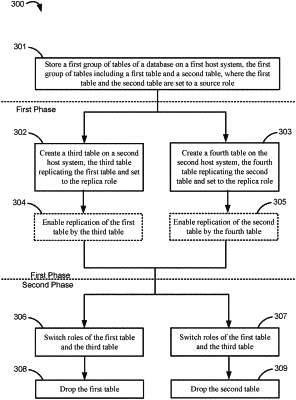| CPC G06F 16/2282 (2019.01) [G06F 16/211 (2019.01); G06F 16/2379 (2019.01); G06F 16/27 (2019.01)] | 20 Claims |

|
1. A computer system, comprising:
one or more processors;
one or more machine-readable medium coupled to the one or more processors and storing computer program code comprising sets instructions executable by the one or more processors to:
store a first group of tables of a database on a first host system, the first group of tables including a first table and a second table, the first table set to a source role, the second table set to the source role;
create a third table on a second host system, the third table replicating the first table and set to a replica role, the creation of the third table including a first transfer of first information of the first table from the first host system to the second host system, the first table and the second table not being locked against modifications during the first transfer of the first information or the creation of the third table;
create a fourth table on the second host system, the fourth table replicating the second table and set to the replica role, the creation of the fourth table including a second transfer of second information of the second table from the first host system to the second host system, the first table and the second table not being locked against modifications during the second transfer of the second information or the creation of the fourth table;
after the creation of the third table and the creation of fourth table, switch roles of the first table and the third table such that the first table stored on the first host system is set to the replica role and the third table stored on the second host system is set to the source role, and switch roles of the second table and the fourth table such that the second table stored on the first host system is set to the replica role and the fourth table stored on the second host system is set to the source role;
drop the first table after the switching of the roles of the first table and the third table; and
drop the second table after the switching of the roles of the second source table and the second replica table.
|